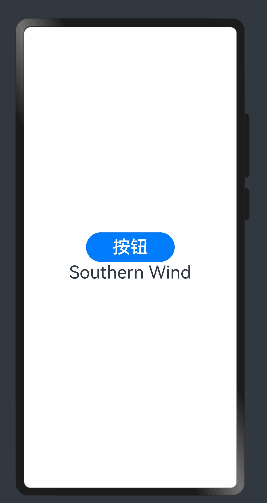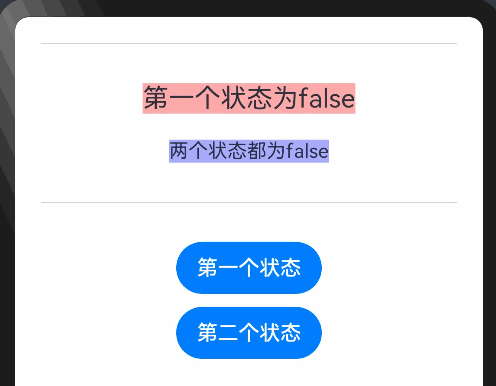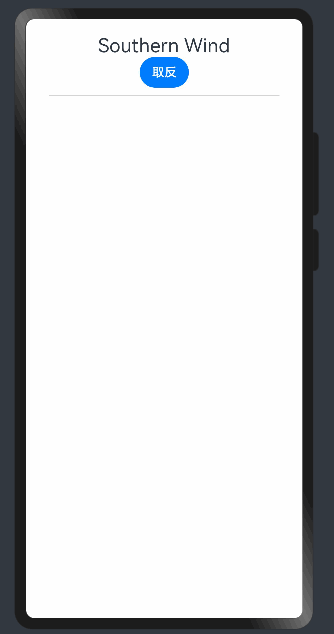HarmonyOS4.0 系列——06、渲染之条件渲染、循环渲染以及懒加载渲染
if/else:条件渲染
ArkTS 提供了渲染控制的能力。条件渲染可根据应用的不同状态,使用 if、else 和 else if 渲染对应状态下的 UI 内容。
写法和 TS 的一样,简单看一下即可
@Entry
@Component
struct IfForEach {@State status: boolean = truebuild() {Row() {Column() {Button('按钮').fontSize(30).width(150).height(50).onClick(() => {this.status = !this.status;})if (this.status) {if_son({ content: 'Southern Wind' })} else {if_son({ content: '隐藏' })}}.width('100%')}.height('100%')}
}@Component
struct if_son {content: stringbuild() {Text(this.content).fontSize(30)}
}效果:

另外,@State 定义的变量归父组件所有。因此,当子组件实例被删除时,该变量不会被销毁。子组件通过@Link装饰器引用状态。状态必须从子级移动到其父级(或父级的父级),以避免在条件内容或重复内容被销毁时丢失状态。
条件语句的嵌套对父组件的相关规则也没有影响。
例:
@Entry
@Component
struct CompA {@State toggle: boolean = false;@State toggleColor: boolean = false;build() {Column() {Divider().margin(20)if (this.toggle) {Text('第一个状态为true').margin(10).backgroundColor('#aaffaa').fontSize(20)// 内部if语句if (this.toggleColor) {Text('两个状态都为true').margin(10).backgroundColor('#00aaaa').fontSize(15)} else {Text('第一个状态为true第二个状态为false').margin(10).backgroundColor('#aaaaff').fontSize(15)}} else {Text('第一个状态为false').fontSize(20).margin(10).backgroundColor('#ffaaaa')if (this.toggleColor) {Text('第一个状态为false,第二个状态为true').margin(10).backgroundColor('#00aaaa').fontSize(15)} else {Text('两个状态都为false').margin(10).backgroundColor('#aaaaff').fontSize(15)}}Divider().margin(20)Button('第一个状态').margin(10).onClick(() => {this.toggle = !this.toggle;})Button('第二个状态').onClick(() => {this.toggleColor = !this.toggleColor;})}.width('100%')}
}
因为他默认两个状态都为 false 触发第一个状态为false'和两个状态都为false文本,
一共是四种效果:
- true true
- ture false
- false false
- false true
效果:

ForEach
接口描述:
ForEach(arr: any[],itemGenerator: (item: any, index?: number) => void,keyGenerator?: (item: any, index?: number) => string
)
第一个参数为数组,允许设置为空数组,空数组场景下将不会创建子组件。
第二个参数其实就是生成遍历出来的元素和索引值,和 js 中 forEach 用法一致,只是写法略微改动。
第三个参数为匿名函数。用于给数组中的每一个数据项生成唯一且固定的键值。键值生成器的功能是可选的,但是,为了使开发框架能够更好地识别数组更改,提高性能,建议提供。如将数组反向时,如果没有提供键值生成器,则 ForEach 中的所有节点都将重建。其实也就是 vue 中 for 循环的唯一键值 key,等同于:key="item.id"或者:key="index"
- ForEach 必须在容器组件内使用。
使用场景
@Entry
@Component
struct ForEachPage {@State message: string = 'Hello World'@State flag: boolean |string = false@State arr: Array<object> = [{id: 1,name: 'ArkTS',},{id: 2,name: 'HTML'},{id: 3,name: 'CSS',},{id: 4,name: 'Javascript'},{id: 5,name: 'PHP'},{id: 6,name: 'WebGL'},{id: 7,name: 'Node'},{id: 8,name: 'Go'}, {id: 9,name: 'Vue'},{id: 10,name: 'react'}, {id: 11,name: 'IOS'}, {id: 12,name: 'Southern Wind'},]build() {Row() {Column() {Text(this.message).fontSize(50)Button('取反').onClick(()=>{this.flag=!this.flag;console.log(`${this.flag}`)})Divider().margin(10)List({ space: 30 }) {if (this.flag){ForEach(this.arr, (item, key) => {ListItem() {Text(`name:${item.name} --id:${item.id} -- key:${key}`).fontSize(30).textAlign(TextAlign.Center).width('100%').lineHeight(45).backgroundColor('#bbb')}}, item => item)}}.width('100%').height('80%')}.padding(20).width('100%')}}
}
效果:

如果渲染长列表的话需要使用List组件,不然数组数据多的情况下滚动会出现问题。
LazyForEach:数据懒加载
LazyForEach 就是滚动到视口的位置是才会加载,比如加载长列表图片,刚开始只渲染视口的数据,当往下拖动时才继续加载列表数据。
接口描述
LazyForEach(dataSource: IDataSource, // 需要进行数据迭代的数据源itemGenerator: (item: any) => void, // 子组件生成函数keyGenerator?: (item: any) => string // (可选) .键值生成函数
): void
官方的表格大家可以看一下具体参数名和描述
参数名 | 参数类型 | 必填 | 参数描述 |
|---|---|---|---|
dataSource | IDataSource | 是 | LazyForEach数据源,需要开发者实现相关接口。 |
itemGenerator | (item: any) => void | 是 | 子组件生成函数,为数组中的每一个数据项创建一个子组件。 说明 itemGenerator的函数体必须使用大括号{...}。itemGenerator每次迭代只能并且必须生成一个子组件。itemGenerator中可以使用if语句,但是必须保证if语句每个分支都会创建一个相同类型的子组件。itemGenerator中不允许使用ForEach和LazyForEach语句。 |
keyGenerator | (item: any) => string | 否 | 键值生成函数,用于给数据源中的每一个数据项生成唯一且固定的键值。当数据项在数组中的位置更改时,其键值不得更改,当数组中的数据项被新项替换时,被替换项的键值和新项的键值必须不同。键值生成器的功能是可选的,但是,为了使开发框架能够更好地识别数组更改,提高性能,建议提供。如将数组反向时,如果没有提供键值生成器,则LazyForEach中的所有节点都将重建。 说明 数据源中的每一个数据项生成的键值不能重复。 |
关于第一个参数IDataSource也有详细的说明
interface IDataSource {totalCount(): number; // 获得数据总数getData(index: number): any; // 获取索引值对应的数据registerDataChangeListener(listener: DataChangeListener): void; // 注册数据改变的监听器unregisterDataChangeListener(listener: DataChangeListener): void; // 注销数据改变的监听器
}
关于事件DataChangeListener
interface DataChangeListener {onDataReloaded(): void; // 重新加载数据时调用onDataAdded(index: number): void; // 添加数据时调用onDataMoved(from: number, to: number): void; // 数据移动起始位置与数据移动目标位置交换时调用onDataDeleted(index: number): void; // 删除数据时调用onDataChanged(index: number): void; // 改变数据时调用onDataAdd(index: number): void; // 添加数据时调用onDataMove(from: number, to: number): void; // 数据移动起始位置与数据移动目标位置交换时调用onDataDelete(index: number): void; // 删除数据时调用onDataChange(index: number): void; // 改变数据时调用
}
使用限制
- LazyForEach必须在容器组件内使用,仅有List、Grid以及Swiper组件支持数据懒加载(可配置cachedCount属性,即只加载可视部分以及其前后少量数据用于缓冲),其他组件仍然是一次性加载所有的数据
- LazyForEach在每次迭代中,必须创建且只允许创建一个子组件。
-允许LazyForEach包含在if/else条件渲染语句中,也允许LazyForEach中出现if/else条件渲染语句。
具体代码可以参考HarmonyOS——LazyForEach






)


- 是一种严格弱序关系(operator< ))


)
。Javaee项目。ssm项目。)




)
